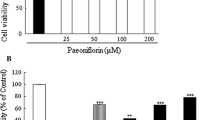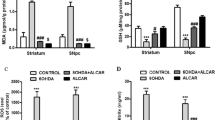Abstract
Objective
Icariin (ICA) has a good neuroprotective effect and can upregulate neuronal basal autophagy in naturally aging rats. Mitochondrial dysfunction is associated with brain aging-related neurodegenerative diseases. Abnormal opening of the mitochondrial permeability transition pore (mPTP) is a crucial factor in mitochondrial dysfunction and is associated with excessive autophagy. This study aimed to explore that ICA protects against neuronal injury by blocking the mPTP opening and down-regulating autophagy levels in a D-galactose (D-gal)-induced cell injury model.
Methods
A cell model of neuronal injury was established in rat pheochromocytoma cells (PC12 cells) treated with 200 mmol/L D-gal for 48 h. In this cell model, PC12 cells were pre-treated with different concentrations of ICA for 24 h. MTT was used to detect cell viability. Senescence associated β-galactosidase (SA-β-Gal) staining was used to observe cell senescence. Western blot analysis was performed to detect the expression levels of a senescence-related protein (p21), autophagy markers (LC3B, p62, Atg7, Atg5 and Beclin 1), mitochondrial fission and fusion-related proteins (Drp1, Mfn2 and Opa1), and mitophagy markers (Pink1 and Parkin). The changes of autophagic flow were detected by using mRFP-GFP-LC3 adenovirus. The intracellular ultrastructure was observed by transmission electron microscopy. Immunofluorescence was used to detect mPTP, mitochondrial membrane potential (MMP), mitochondrial reactive oxygen species (mtROS) and ROS levels. ROS and apoptosis levels were detected by flow cytometry.
Results
D-gal treatment significantly decreased the viability of PC12 cells, and markedly increased the SA-β-Gal positive cells as compared to the control group. With the D-gal stimulation, the expression of p21 was significantly up-regulated. Furthermore, D-gal stimulation resulted in an elevated LC3B II/I ratio and decreased p62 expression. Meanwhile, autophagosomes and autolysosomes were significantly increased, indicating abnormal activation of autophagy levels. In addition, in this D-gal-induced model of cell injury, the mPTP was abnormally open, the ROS generation was continuously increased, the MMP was gradually decreased, and the apoptosis was increased. ICA effectively improved mitochondrial dysfunction to protect against D-gal-induced cell injury and apoptosis. It strongly inhibited excessive autophagy by blocking the opening of the mPTP. Cotreatment with ICA and an mPTP inhibitor (cyclosporin A) did not ameliorate mitochondrial dysfunction. However, the protective effects were attenuated by cotreatment with ICA and an mPTP activator (lonidamine).
Conclusion
ICA inhibits the activation of excessive autophagy and thus improves mitochondrial dysfunction by blocking the mPTP opening.
Similar content being viewed by others
References
Guo Y, Guan T, Shafiq K, et al. Mitochondrial dysfunction in aging. Ageing Res Rev, 2023,88:101955
Miwa S, Kashyap S, Chini E, et al. Mitochondrial dysfunction in cell senescence and aging. J Clin Invest, 2022,132(13):e158447
Murphy MP, O’Neill LAJ. A break in mitochondrial endosymbiosis as a basis for inflammatory diseases. Nature, 2024,626(7998):271–279
Kwong JQ, Molkentin JD. Physiological and pathological roles of the mitochondrial permeability transition pore in the heart. Cell Metab, 2015,21(2):206–214
Liu J, Liu W, Lu Y, et al. Piperlongumine restores the balance of autophagy and apoptosis by increasing BCL2 phosphorylation in rotenone-induced Parkinson disease models. Autophagy, 2018,14(5):845–861
Zorov DB, Juhaszova M, Sollott SJ. Mitochondrial reactive oxygen species (ROS) and ROS-induced ROS release. Physiol Rev, 2014,94(3):909–950
Rottenberg H, Hoek JB. The path from mitochondrial ROS to aging runs through the mitochondrial permeability transition pore. Aging Cell, 2017,16(5):943–955
Aspernig H, Heimbucher T, Qi W, et al. Mitochondrial Perturbations Couple mTORC2 to Autophagy in C. elegans. Cell Rep, 2019,29(6):1399–1409.e5
Zhou B, Kreuzer J, Kumsta C, et al. Mitochondrial Permeability Uncouples Elevated Autophagy and Lifespan Extension. Cell, 2019,177(2):299–314.e16
Zheng J, Hu S, Wang J, et al. Icariin improves brain function decline in aging rats by enhancing neuronal autophagy through the AMPK/mTOR/ULK1 pathway. Pharm Biol, 2021,59(1):183–191
Hua W, Li S, Luo R, et al. Icariin protects human nucleus pulposus cells from hydrogen peroxide-induced mitochondria-mediated apoptosis by activating nuclear factor erythroid 2-related factor 2. Biochimica et biophysica acta. Mol Basis Dis, 2020,1866(1):165575
Zheng L, Wu S, ** H, et al. Molecular mechanisms and therapeutic potential of icariin in the treatment of Alzheimer’s disease. Phytomedicine, 2023,116:154890
Hakimizadeh E, Zamanian M, Giménez-Llort L, et al. Calcium Dobesilate Reverses Cognitive Deficits and Anxiety-Like Behaviors in the D-Galactose-Induced Aging Mouse Model through Modulation of Oxidative Stress. Antioxidants (Basel), 2021,10(5):649
Lu S, Zhou J, Yang C, et al. γ-Glutamylcysteine ameliorates D-gal-induced senescence in PC12 cells and mice via activating AMPK and SIRT1. Food Funct, 2022,13(14):7560–7571
Kim SJ, Devgan A, Miller B, et al. Humanin-induced autophagy plays important roles in skeletal muscle function and lifespan extension. Biochim Biophys Acta Gen Subj, 2022,1866(1):130017
Shao Y, Sun L, Yang G, et al. Icariin protects vertebral endplate chondrocytes against apoptosis and degeneration via activating Nrf-2/HO-1 pathway. Front Pharmacol, 2022,13:937502
Wu B, Chen Y, Huang J, et al. Icariin improves cognitive deficits and activates quiescent neural stem cells in aging rats. J Ethnopharmacol, 2012,142(3):746–753
Sun N, Youle R, Finkel T. The Mitochondrial Basis of Aging. Molecular cell, 2016,61(5):654–666
Rubinsztein D, Mariño G, Kroemer G. Autophagy and aging. Cell, 2011,146(5):682–695
Yao X, **g X, Guo J, et al. Icariin Protects Bone Marrow Mesenchymal Stem Cells Against Iron Overload Induced Dysfunction Through Mitochondrial Fusion and Fission, PI3K/AKT/mTOR and MAPK Pathways. Front Pharmacol, 2019,10:163
He W, Liu H, Hu L, et al. Icariin improves testicular dysfunction via enhancing proliferation and inhibiting mitochondria-dependent apoptosis pathway in high-fat diet and streptozotocin-induced diabetic rats. Reprod Biol Endocrinol, 2021,19(1):168
Chen F, Liu B, Wu Q, et al. Icariin Delays Brain Aging in Senescence-Accelerated Mouse Prone 8 (SAMP8) Model via Inhibiting Autophagy. J Pharmacol Exp Ther, 2019,369(1):121–128
Chen P, Chen F, Lei J, et al. Activation of the miR-34a-Mediated SIRT1/mTOR Signaling Pathway by Urolithin A Attenuates D-Galactose-Induced Brain Aging in Mice. Neurotherapeutics, 2019,16(4):1269–1282
Hsu WH, Huang NK, Shiao YJ, et al. Gastrodiae rhizoma attenuates brain aging via promoting neuritogenesis and neurodifferentiation. Phytomedicine, 2021,87:153576
Stavoe A, Holzbaur E. Autophagy in Neurons. Annu Rev Cell Dev Biol, 2019,35:477–500
Wenzel K, Krämer E, Geertz B, et al. A Transgenic Mouse Model of Eccentric Left Ventricular Hypertrophy With Preserved Ejection Fraction Exhibits Alterations in the Autophagy-Lysosomal Pathway. Front Physiol, 2021,12:614878
Fernández Á, Sebti S, Wei Y, et al. Disruption of the beclin 1-BCL2 autophagy regulatory complex promotes longevity in mice. Nature, 2018,558(7708):136–140
He B, Wang X, Zhu J, et al. Autophagy protects murine macrophages from β-cypermethrin-induced mitochondrial dysfunction and cytotoxicity via the reduction of oxidation stress. Environ Pollut, 2019,250:416–425
Fu X, Chen S, Wang X, et al. Dendrobium nobile Lindl. alkaloids alleviate Mn-induced neurotoxicity via PINK1/Parkin-mediated mitophagy in PC12 cells. Biochem Biophys Rep, 2021,26:100877
Author information
Authors and Affiliations
Corresponding authors
Ethics declarations
The authors declare that there are no conflicts of interest.
Additional information
This study was supported by the Natural Science Foundation of Yichang City of China (No. A23-1-075).
Rights and permissions
About this article
Cite this article
Hu, Ss., Wang, Ty., Ni, L. et al. Icariin Ameliorates D-galactose-induced Cell Injury in Neuron-like PC12 Cells by Inhibiting MPTP Opening. CURR MED SCI (2024). https://doi.org/10.1007/s11596-024-2892-0
Received:
Accepted:
Published:
DOI: https://doi.org/10.1007/s11596-024-2892-0




